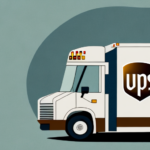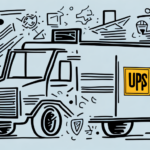Understanding the Process of a UPS Commercial Adjustment
UPS commercial adjustment is a process that allows businesses to receive refunds for package shipment services that did not meet their expectations. This process can help businesses save money and ensure that they are maximizing their shipping investments. In this article, we will explore the fundamentals of UPS commercial adjustment, the reasons businesses may need it, the types of adjustments available, the application process, and the factors that influence the outcome of an adjustment.
The Basics of UPS Commercial Adjustment
UPS commercial adjustment is a mechanism by which businesses can obtain refunds for shipment services that failed to meet predefined standards. This includes instances where packages were delivered late, damaged, lost, or incorrectly priced. To secure a refund, businesses must submit a claim to UPS within a specified timeframe following the shipment of the package. This process ensures that businesses receive the refunds they are entitled to, thereby optimizing their shipping expenditures.
Maintaining diligent records of shipments and monitoring delivery statuses are crucial for businesses to determine their eligibility for refunds through UPS commercial adjustment. UPS provides various tools and services to assist businesses in tracking their shipments and identifying potential issues promptly. By leveraging these resources, businesses can streamline their shipping operations and reduce the risk of lost or damaged packages.
Why Do Businesses Need UPS Commercial Adjustments?
For businesses that depend on shipping services, shipping costs can accumulate rapidly. Problems such as delivery delays or incorrect pricing can have a significant impact on a business's profitability. UPS commercial adjustment provides a way for businesses to reclaim money for subpar services, ensuring they only pay for services that meet their expectations. Additionally, this process holds shipping carriers accountable for adhering to their service level agreements, potentially leading to enhanced service quality and fewer issues over time.
Another advantage of UPS commercial adjustments is the ability to identify opportunities for optimizing shipping processes. By analyzing shipping data, businesses can uncover patterns and trends that inform more effective shipping strategies. This analytical approach can lead to more efficient and cost-effective shipping practices, ultimately benefiting the business's financial health.
Moreover, UPS commercial adjustments assist businesses in staying compliant with shipping regulations, helping them avoid costly penalties. Shipping regulations can be intricate and frequently updated, making it challenging for businesses to stay current. Through commercial adjustments, businesses can ensure compliance with the latest regulations, thereby avoiding fines and legal complications.
How to Determine if Your Business Qualifies for a UPS Commercial Adjustment
To qualify for a UPS commercial adjustment, businesses must satisfy specific criteria. Typically, this involves maintaining a regular shipping volume and meeting particular standards related to the problematic shipment, such as delivery timelines, pricing accuracy, or package condition. Additionally, certain package types, like Mail Innovations or SurePost, may have distinct requirements. Businesses can assess UPS's terms and conditions or consult with a UPS representative to ascertain if their shipment qualifies for a commercial adjustment.
It's essential to recognize that UPS commercial adjustments are not automatically granted and are subject to approval. Businesses may need to furnish additional documentation or evidence to substantiate their claims. Regularly reviewing shipping invoices is also advisable to ensure accurate billing and to identify potential opportunities for cost recovery through commercial adjustments. By remaining informed and proactive, businesses can enhance their shipping efficiency and reduce expenses.
The Different Types of UPS Commercial Adjustments Available
UPS provides several categories of commercial adjustments based on the specific issue encountered with the shipment. These include:
- Late package refunds
- Incorrect packaging charges refunds
- Invoice corrections
- Lost package refunds
- Damaged package refunds
- Miscellaneous refunds (e.g., address corrections)
Businesses must submit claims corresponding to the appropriate type of commercial adjustment to receive the applicable refund.
It's important to note that UPS has established guidelines and deadlines for submitting commercial adjustment claims. For instance, claims for lost or damaged packages must be filed within 60 days of the shipment date. Additionally, businesses are required to provide supporting documentation, such as invoices or receipts, to validate the package's value and the requested refund amount.
UPS also offers a service called UPS Quantum View, which enables businesses to track and manage their shipments in real-time. This service grants businesses increased visibility into their supply chain, allowing them to proactively identify and resolve issues that may necessitate a commercial adjustment. Utilizing UPS Quantum View can help businesses minimize shipping errors and reduce the frequency of commercial adjustment claims.
The Process of Applying for a UPS Commercial Adjustment
To apply for a UPS commercial adjustment, businesses must submit a claim online through the UPS Billing Center. The claim should include pertinent information about the shipment, such as the tracking number, shipment date, and the specific issue encountered. Additionally, businesses must provide documentation to support their claim, such as a delivery receipt or photographs of a damaged package. Once UPS receives the claim, an investigation is conducted to determine the eligibility for a refund.
It's crucial for businesses to submit their claims within 15 days of the delivery date to qualify for a commercial adjustment. If the claim is approved, UPS will process the refund within 7-10 business days. However, if the claim is denied, businesses have the option to appeal the decision by supplying additional documentation or evidence to support their case. Maintaining organized shipment records and promptly addressing any issues can facilitate a swift resolution to commercial adjustment claims.
How to Prepare for the UPS Commercial Adjustment Process
Preparing for the UPS commercial adjustment process involves maintaining comprehensive records of all shipments. This includes tracking numbers, shipment dates, and associated shipping costs. Additionally, businesses should familiarize themselves with UPS's terms and conditions to ensure they meet all necessary requirements for a commercial adjustment. Being prepared to provide supporting documentation, such as delivery receipts or images of damaged packages, is also essential.
Understanding the timelines for filing commercial adjustment claims is another critical aspect of preparation. Claims for packages delivered late or damaged must be filed within 15 days of the delivery date, while claims for lost packages have a 60-day window from the shipment date. Businesses should also anticipate that UPS might request additional information or documentation during the claims process and be ready to provide it promptly to prevent delays in claim resolution.
Common Mistakes to Avoid During a UPS Commercial Adjustment
When filing for a UPS commercial adjustment, businesses should steer clear of common errors that could result in claim denial. These mistakes include submitting incomplete or inaccurate information, missing the claim submission deadlines, or failing to provide adequate documentation to support the claim. It's advisable for businesses to meticulously review their claims before submission to ensure compliance with all requirements.
Another frequent mistake is not supplying sufficient evidence to back the claim. Providing detailed documentation, such as invoices, receipts, and shipping labels, is vital to substantiate the value of lost or damaged items. Without robust evidence, claims are more likely to be denied or only partially approved.
Furthermore, businesses should be mindful of the specific rules and regulations governing UPS commercial adjustment claims, as these may vary based on the type of shipment and the destination country. Conducting thorough research and understanding these requirements before submitting a claim can help avoid potential issues or delays in the process.
Tips for a Successful UPS Commercial Adjustment
To enhance the likelihood of a successful UPS commercial adjustment, businesses should:
- Maintain detailed records of all shipments.
- Regularly review UPS's terms and conditions.
- Provide all necessary documentation to support claims, such as photos of damaged packages or delivery receipts.
- Follow up with UPS after submitting a claim to ensure timely review and processing.
Understanding the various types of claims that can be filed is also beneficial. Businesses can file claims for lost or damaged packages, late deliveries, or incorrect billing. It's important to comprehend the specific requirements and documentation needed for each claim type.
Additionally, collaborating with a UPS representative or a third-party logistics provider can be advantageous. These experts can offer guidance on the most effective ways to file claims and ensure that all necessary documentation is included. They can also help businesses navigate their rights and responsibilities under UPS's terms and conditions.
What to Expect During the UPS Commercial Adjustment Process
During the UPS commercial adjustment process, businesses can anticipate that UPS will conduct an investigation to verify eligibility for a refund. This investigation involves reviewing the documentation provided by the business and examining the details of the package delivery. After completing the investigation, UPS will communicate its decision to the business and issue any applicable refunds if approved.
How Long Does the UPS Commercial Adjustment Process Take?
The duration of the UPS commercial adjustment process can vary based on the claim's type and complexity. Typically, UPS responds to a claim within five business days of receipt. Following the investigation, any applicable refunds are usually credited to the business's account within one to two billing cycles.
Factors That Affect the Outcome of a UPS Commercial Adjustment
Several factors can influence the outcome of a UPS commercial adjustment, including:
- The nature of the adjustment being requested.
- The completeness and accuracy of the documentation provided.
- The clarity and correctness of the information submitted.
- Any changes to UPS's terms and conditions over time, which may affect eligibility.
Understanding the Results of Your UPS Commercial Adjustment
After UPS completes its investigation, it will inform the business of its decision and issue any relevant refunds. Businesses should carefully review the results to fully understand the reasons behind the adjustment and the refunded amount. If a claim is denied, it is important for businesses to examine the provided reasoning and consider whether further action, such as an appeal, is warranted.
How to Maximize Your Savings with a UPS Commercial Adjustment
To maximize savings through UPS commercial adjustments, businesses should:
- Maintain meticulous shipment records.
- Regularly review and understand UPS's terms and conditions.
- Provide comprehensive documentation to support claims.
- Consistently monitor shipping costs to identify potential issues that could lead to commercial adjustments.
By adopting a proactive and vigilant approach, businesses can ensure they are making the most of their shipping expenditures and securing any refunds they are eligible for.




















